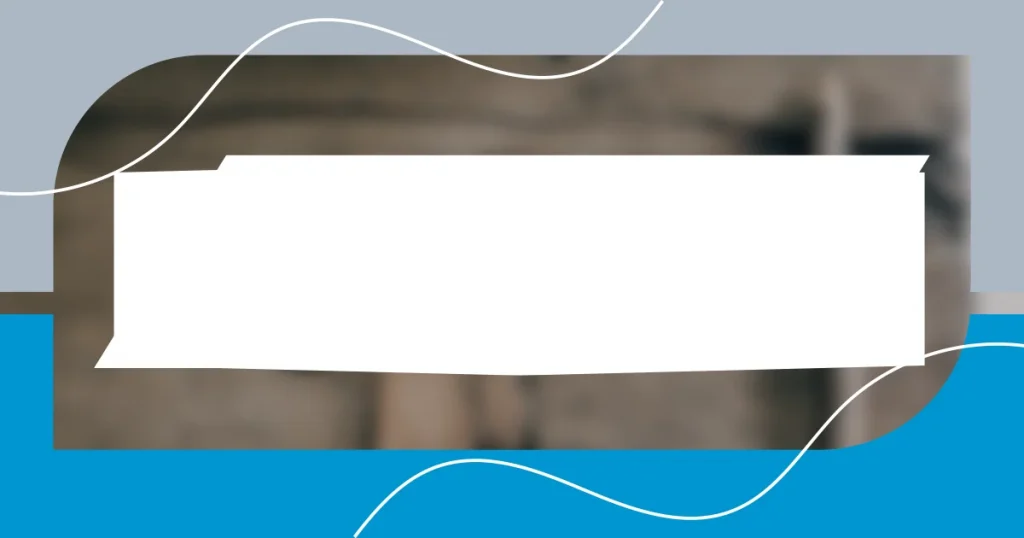Key takeaways:
- Proper surface preparation, including sanding and cleaning, is essential for achieving a professional finish and preventing errors.
- Choosing the right finish involves considering the piece’s purpose, desired aesthetic, application ease, and environmental factors.
- Patience and high-quality materials, along with testing finishes on scrap wood, are crucial for achieving satisfying and consistent results.

Common wood finishing mistakes
One common mistake I often see, and have even fallen victim to myself, is not prepping the wood surface properly. It’s like trying to paint a wall without cleaning it first. I remember the frustration of applying finish to a beautiful piece, only to find dust specks ruining the entire project. Have you ever had that sinking feeling when you realize you’ve overlooked something so fundamental?
Another blunder that frequently crops up is rushing the drying times. Early in my wood finishing journey, I was impatient and thought I could push the boundaries by applying a second coat too soon. Looking back, I can still see those unsightly drips and smudges. It makes me wonder—how often do we prioritize speed over quality in our projects?
Lastly, a major rookie error is choosing the wrong finish for the intended use of the wood. I learned this the hard way after using a glossy varnish on a dining table that saw a lot of family dinners and spills. The surface looked fantastic initially, but soon it became slippery and hard to maintain. Have you ever felt the disappointment of a product that fails to meet your expectations? It really emphasizes the importance of selecting finishes that align with the function and aesthetics of your piece.

Understanding finishing products
Understanding different finishing products can significantly alter the outcome of your project. There are various types of finishes available, each offering unique benefits and characteristics. For instance, when I first experimented with oil finishes, I was captivated by how they enhanced the natural grain of the wood. It felt as if the wood came to life, each brushstroke revealing hidden textures. Have you explored how different finishes interact with your wood choices? It can be quite enlightening.
As I transitioned into working with water-based finishes, I found myself excited by the ease of cleanup and quick drying times. However, I also learned to appreciate the trade-offs, like the need for more coats to achieve a similar depth of color compared to oils. My experience reminds me that understanding these nuances helps us make informed decisions, ultimately leading to more satisfying results.
To truly appreciate finishing products, it’s essential to consider their components and intended uses. For example, I remember the disappointment of using a quick-drying polyurethane on a hardwood floor. Although it had a beautiful sheen, it didn’t provide the durability I craved for such a high-traffic area. Each product serves a specific function, and knowing what you need is half the battle.
| Type of Finish | Description |
|---|---|
| Oil Finish | Enhances wood grain; more time-consuming to apply but offers deep penetration. |
| Water-Based Finish | Quick drying and easy cleanup; may need additional coats for color depth. |
| Varnish | A durable film finish, suitable for high-use surfaces, but can be tricky to apply evenly. |
| Shellac | Natural finish with a warm tone; ideal for indoor projects but sensitive to moisture. |

Choosing the right wood finish
When it comes to choosing the right wood finish, the decision can be as personal as selecting a paint color for your living room. I vividly recall standing in the aisle of my local hardware store, overwhelmed by the sheer number of options. What struck me most was not just the colors but how each finish would react differently to the wood’s natural beauty. Sometimes, the finish is just as significant as the wood species you select, and that’s a lesson I learned through plenty of trial and error.
To help guide your selection process, consider these key points:
– Purpose of the Piece: Ask yourself what the furniture will endure. High-traffic items, like dining tables, may require a tougher finish.
– Desired Aesthetic: Reflect on how you want the wood to look. Do you prefer a matte, glossy, or satin finish that enhances the grain?
– Application Process: Some finishes are more user-friendly than others. Fewer steps might appeal to beginners, while seasoned woodworkers might enjoy the complexity of oils or varnishes.
– Environmental Considerations: If you’re sensitive to fumes or working in a small space, opting for low-VOC (volatile organic compounds) finishes might be wise.
Choosing the right finish is often a balancing act between function and beauty. I faced this dilemma when finishing a walnut coffee table for my living room; I was torn between the rich, warm tones of an oil finish and the durability of a more synthetic option. Ultimately, I chose the oil because it brought out the wood’s character beautifully, despite knowing it would need reapplication over time. That moment of leaning into the wood’s natural beauty taught me to embrace the journey rather than rushing to a conclusion. Each choice I made was a step toward not just a finished product, but a piece of art that reflects my personality.

Proper surface preparation techniques
Preparing the surface before finishing is vital for achieving that flawless, professional look. I learned this the hard way while refinishing an old dresser—skipping the sanding phase led to an uneven application that haunted me throughout the project. Have you ever prematurely jumped into a task only to regret it later? Taking the time to properly sand and clean the surface can save countless hours spent correcting avoidable mistakes.
Sanding is more than just a preliminary step; it’s a way to rejuvenate the wood and create a smooth canvas for the finish. For instance, I vividly remember the first time I used a random orbital sander. The joy of watching the wood transform, revealing its beauty with each pass, was immensely satisfying. I can’t emphasize enough how important it is to start with the right grit sandpaper—generally, begin with a coarser grit and gradually move to a finer one. This approach really helped me to avoid those unsightly scratches that can mar the final finish.
After sanding, the cleaning step often gets overlooked, but I’ve learned it’s just as crucial. Dust particles left on the surface can create a rough texture and lead to imperfections in the finish. I’ve made it a habit to wipe down surfaces with a tack cloth or a damp rag after sanding. This small step can make a world of difference. Trust me; it’s a detail that has turned many of my “good” finishes into truly great ones. What little habits have you developed in your finishing process that elevate your work?

Techniques for even application
Achieving an even application of wood finish is all about the right techniques. One approach I find effective is using a foam brush. I remember my first attempt at applying varnish with a traditional bristle brush; it left streaks that made me cringe. Switching to a foam brush changed everything for me. The smooth, even strokes helped ensure consistent coverage, and I found it much easier to avoid pesky bubbles or brush marks. Have you tried one? If not, I encourage you to give it a shot; you might be surprised by the difference.
Another technique that has truly transformed my finishing game is working in thin layers. I recall applying a thick coat on a project early in my woodworking journey, thinking it would save time. Instead, it led to uneven drying and a mess I had to fix later. Now, I focus on applying several light coats, allowing proper drying time in between. This method not only enhances the finish’s depth but also minimizes potential drips and runs. Just think about it—would you rather spend a bit more time for a flawless finish or tackle a larger problem later on?
Lastly, I can’t stress enough the importance of the right environment. I learned this the hard way while working in my basement during winter when the humidity was off the charts. The moisture in the air caused my finish to dry unevenly, leaving me with a patchy surface. Now, I always ensure I’m in a well-ventilated, temperature-controlled area before I start. It makes a huge difference, doesn’t it? Think about where you apply your finishes. Is it consistently conducive to great results?

Fixing finish application errors
Sometimes, despite our best efforts, application errors sneak in. I remember a project where I applied a polyurethane finish only to find that it dried with a sticky sheen. At first, I felt defeated, questioning if I had used the right technique. However, I learned that a quick fix involved lightly sanding the surface with fine-grit sandpaper, then applying a new coat. It was a game-changer, making the surface smooth again and restoring its beauty.
Another time, I faced the dilemma of bubbles during application. It happened during a late-night finishing session when I was running on fumes. I had rushed through the application, neglecting my usual caution. To remedy this, I grabbed a fresh brush and gently brushed over the bubbles, coaxing them out, which thankfully worked like a charm. Let me ask you, have you ever had to improvise in a pinch? Those moments, while nerve-wracking, often teach us valuable lessons about patience and technique.
Balancing finish thickness can also be tricky. I recall a time when a thick coat left my piece looking more like a plastic toy than a beautiful wooden creation. The fix? I discovered the beauty of thinning my finish with a compatible solvent. It allowed for a smoother application that enhanced the wood grain rather than obscured it. Have you experimented with adjusting the finish viscosity before? You might find that a little tweak can elevate your work significantly.

Tips for achieving perfect results
To achieve perfect results in wood finishing, the first tip I’d recommend is to always test your finish on a scrap piece of wood that matches your project. I learned this the hard way when I finished a beautifully crafted table, only to realize the stain turned out much darker than I anticipated. It was a gut-wrenching moment! Now, I always set aside a small piece to experiment with different stains and finishes. It gives me peace of mind and helps avoid surprises.
Another crucial aspect is patience. I remember feeling pressure to rush through a project, only to deal with a heavy buildup of finish that looked drippy and unappealing. Waiting between coats feels tedious at times, but those few extra hours or even days make all the difference in achieving a smooth, professional look. Have you ever faced the dilemma of wanting to get it done quickly? Trust me, taking your time pays off in the end.
Lastly, I can’t emphasize enough the importance of using high-quality materials. Early on, I opted for budget brushes and finishes thinking I’d save some money. It turned out to be a costly mistake when bristles shed and finishes failed to adhere properly. Since then, I’ve learned that investing in good tools and finishes elevates my work significantly. What about you—have you noticed a difference when using better materials? It’s all part of the journey towards achieving the results you desire.
















